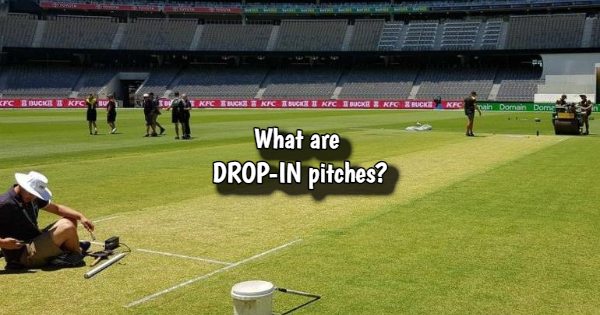Advertisements
the initial first drop-in pitch in cricket was utilised by WACA curator John Maley in the 1970s for World Series Cricket matches. There has been a big rise in cricket played in new places. One example is the T20 World Cup 2024 played in the United States. Fans watched matches in cities not known for cricket.
Many people asked, What is a drop‑in pitch in cricket, A drop‑in pitch in cricket is a way to bring a ready‑made cricket surface into a stadium. It helps venues that normally host other sports to stage cricket games. The idea of What is a drop‑in pitch in cricket has become more known as cricket spreads into new countries. This simple method makes it easy to play cricket in many stadiums.
What Is a Drop‑In Pitch?
Advertisements
A drop‑in pitch in cricket is a special playing area made away from the stadium. Groundskeepers grow and prepare the soil, grass, and clay in trays at a nursery. When it is time to play, they carry these trays to the stadium field. They drop in the trays into a pit dug in the ground. The trays sit level with the rest of the outfield. Players then play on the drop‑in pitch in cricket just as they would on a normal pitch. This process allows for quick setup and removal. It also lets staff perfect the playing surface in a controlled place.

Historical Origins
People first used drop‑in pitches in cricket long ago in the 1970s. The World Series Cricket needed cricket fields in big stadiums for TV matches. Kerry Packer’s league used modern ideas to grow cricket in front of cameras. John Maley, the curator at the WACA in Perth, made the very first drop‑in pitch in cricket. He grew and tested trays of soil and grass off‑site. Then he brought them into the stadium. This step changed how people thought about preparing cricket fields. From then on, drop‑in pitches in cricket let matches happen in many kinds of venues.
Manufacturing and Preparation
To make a drop‑in pitch in cricket, experts use heavy steel frames. Inside each frame is a mix of soil, grass seed, and clay. The soil mix needs the right amount of clay so the ball bounces well. Grounds teams grow the grass in greenhouses. They can control heat, light, and water to make strong grass roots. Over months or years, the trays mature. Staff cut and roll the trays until they reach needed thickness. Once ready, the trays move from the nursery to the stadium. This careful process makes sure the drop‑in pitch in cricket plays well and lasts many games.

Advertisements
Installation and Logistics
Moving and setting up a drop‑in pitch in cricket takes planning. Heavy trucks and cranes carry the steel trays on special frames. For the T20 World Cup 2024 in the USA, more than twenty large trucks drove from Florida to New York with trays inside. At the stadium, crews dig a flat pit and level it carefully. Then they lower the trays into place so the grass is flush with the outfield. After cricket matches, grounds teams swap the cricket tray for a tray of football or rugby turf. This swap‑over keeps venues ready for other sports soon after cricket ends.
Advantages of Drop‑In Pitches
A key benefit of a drop‑in pitch in cricket is its versatility. Stadiums that host multiple sports can plan a cricket season and then switch back to football or rugby. The trays let grounds teams prepare the pitch in a nursery without disturbing the field. This means less downtime between sports events. Another advantage is consistency. Groundskeepers can control the soil and grass mix for each drop‑in pitch in cricket. Players get similar bounce and pace, no matter which stadium they visit. This helps teams know what to expect and makes the game fairer.

Criticisms and Challenges
Some people say a drop‑in pitch in cricket feels too flat. Traditional pitches have small cracks and natural wear that help spin bowlers. Drop‑in pitches may miss those features. At times, the ball can come onto the bat too evenly. Also, if the trays are not placed perfectly, the pitch might have uneven bounce. Players have raised safety concerns when they meet a hidden seam between tray edges. In New York during the T20 World Cup, a few players said the bounce was odd. These challenges show drop‑in pitches in cricket still need fine tuning.
Global Usage and Case Studies
In Australia and New Zealand, a drop‑in pitch in cricket is common. Big venues like the Melbourne Cricket Ground, Optus Stadium, Eden Park, and Westpac Stadium host cricket, football, and rugby. They use trays to switch surfaces each season. Grounds crews work year‑round at nurseries to keep many trays ready.
In the United States, the T20 World Cup 2024 brought cricket to non‑traditional stadiums. The drop‑in trays were made in Florida and moved by road to New York. Fans saw international stars play on these trays. Meanwhile, Pakistan plans its own rollout. The PCB signed an agreement in 2021 to install trays in Karachi and Lahore. The country hopes drop‑in pitches in cricket will help its domestic and international games too.
Future Trends and Innovations
Experts are testing new blends of natural and synthetic fibers for drop‑in pitches in cricket. These hybrids aim to add some natural pitch behaviour while staying durable. Automation is another big trend. Machines that lift, move, and place trays could make installations faster and safer. In some places, indoor cricket halls may use modular trays to create full fields inside large buildings. Soon, remote sensing could track pitch wear and guide reconditioning schedules. All these ideas show drop‑in pitches in cricket will keep evolving. The goal is to make ready‑made pitches feel as close as possible to traditional turf.
Conclusion
Now you know what is a drop‑in pitch in cricket. This method began in the 1970s and grew as cricket needed to reach new places. Groundskeepers make trays with careful soil, clay, and grass mixes in nurseries. They bring the trays into multi‑sport venues by truck and crane. The system gives stadiums flexibility, but some players find the bounce too flat. As cricket grows in the USA, Pakistan, and beyond, drop‑in pitches in cricket will keep improving. New materials and machines promise more natural play and quicker swaps. Drop‑in pitches in cricket are at the heart of cricket’s expansion into the world.
Related Posts:
- Who is the Godfather of cricket ?All you need to know
- Explained: What is lunch time in Test cricket
- All trophies won by MS Dhoni – get full list
- All major trophies won by Virat Kohli – get full list
- Explained: Match abandoned meaning in cricket
- Going, going, gone! The longest six in cricket
- What is Duckworth-Lewis-Stern Method in Cricket
- Kings vs Titans T10 2025: Cricket schedule, fixtures
- Pakistan Super League Winners List: Islamabad United Only Team With Three PSL Titles
- Babar Azam vs Virat Kohli: A Detailed Look at the duo’s numbers across formats